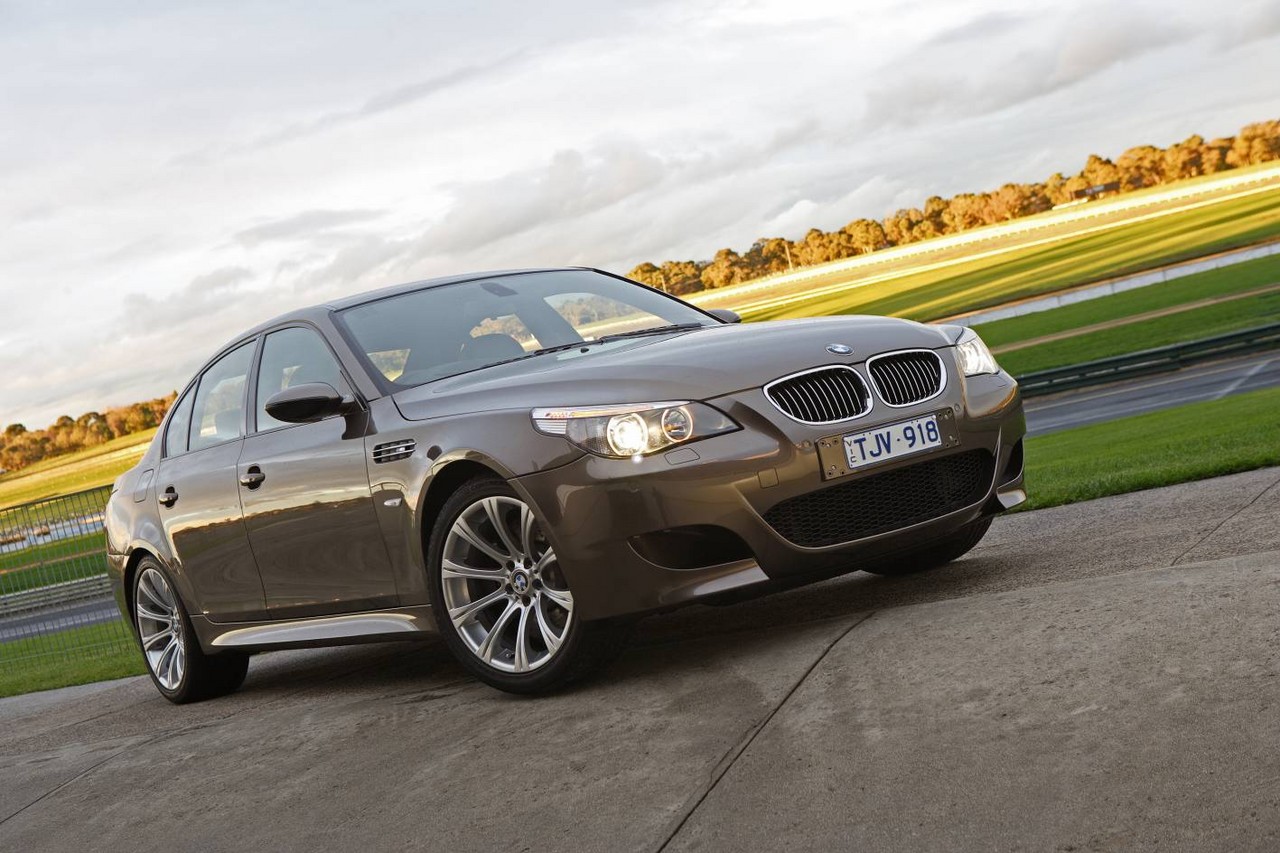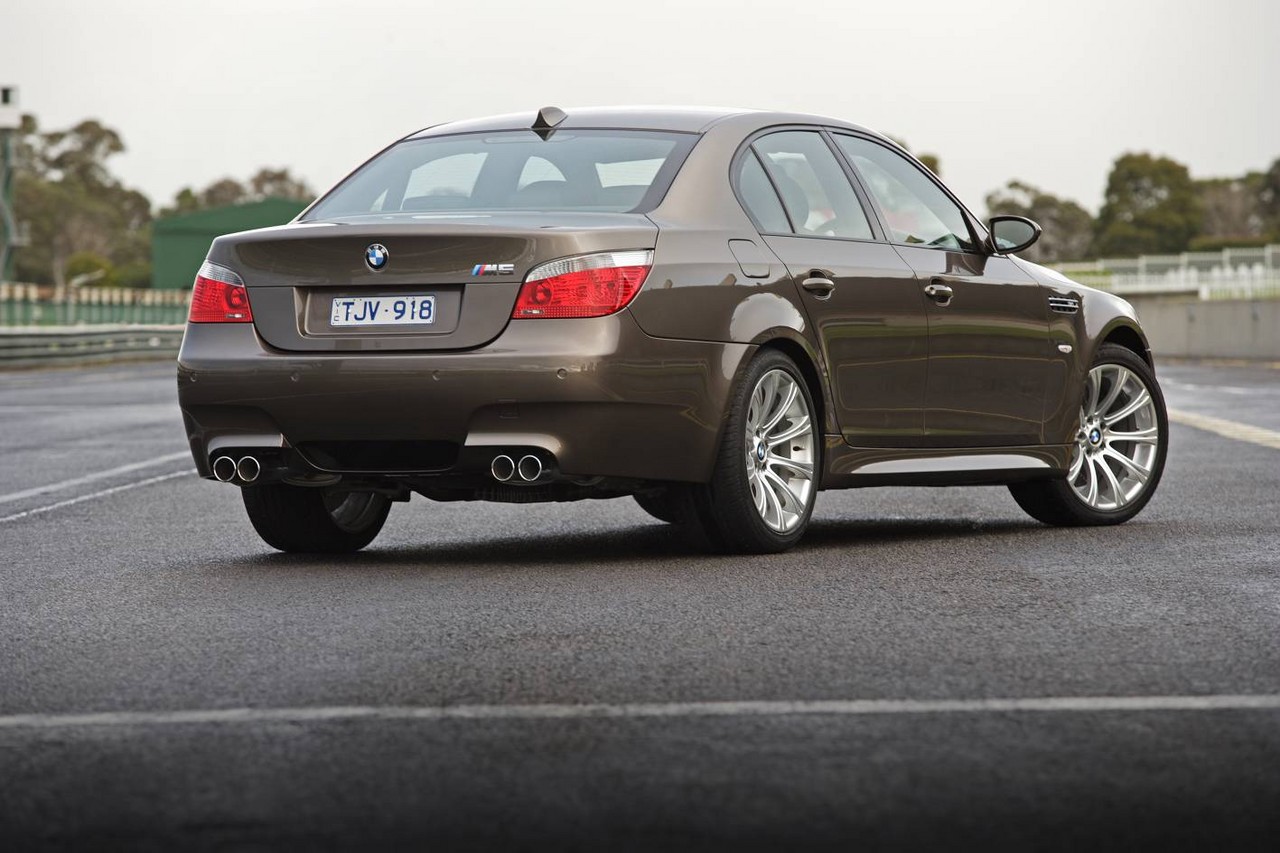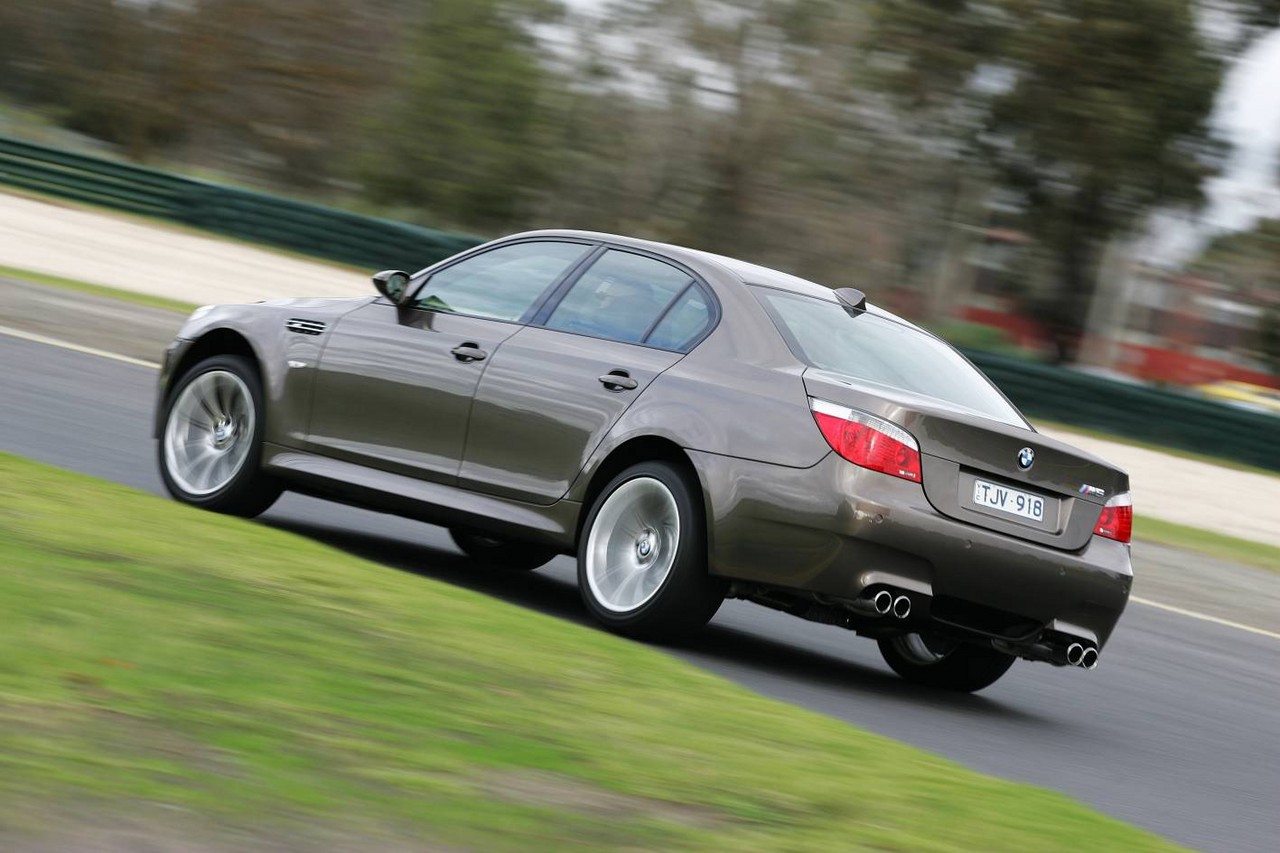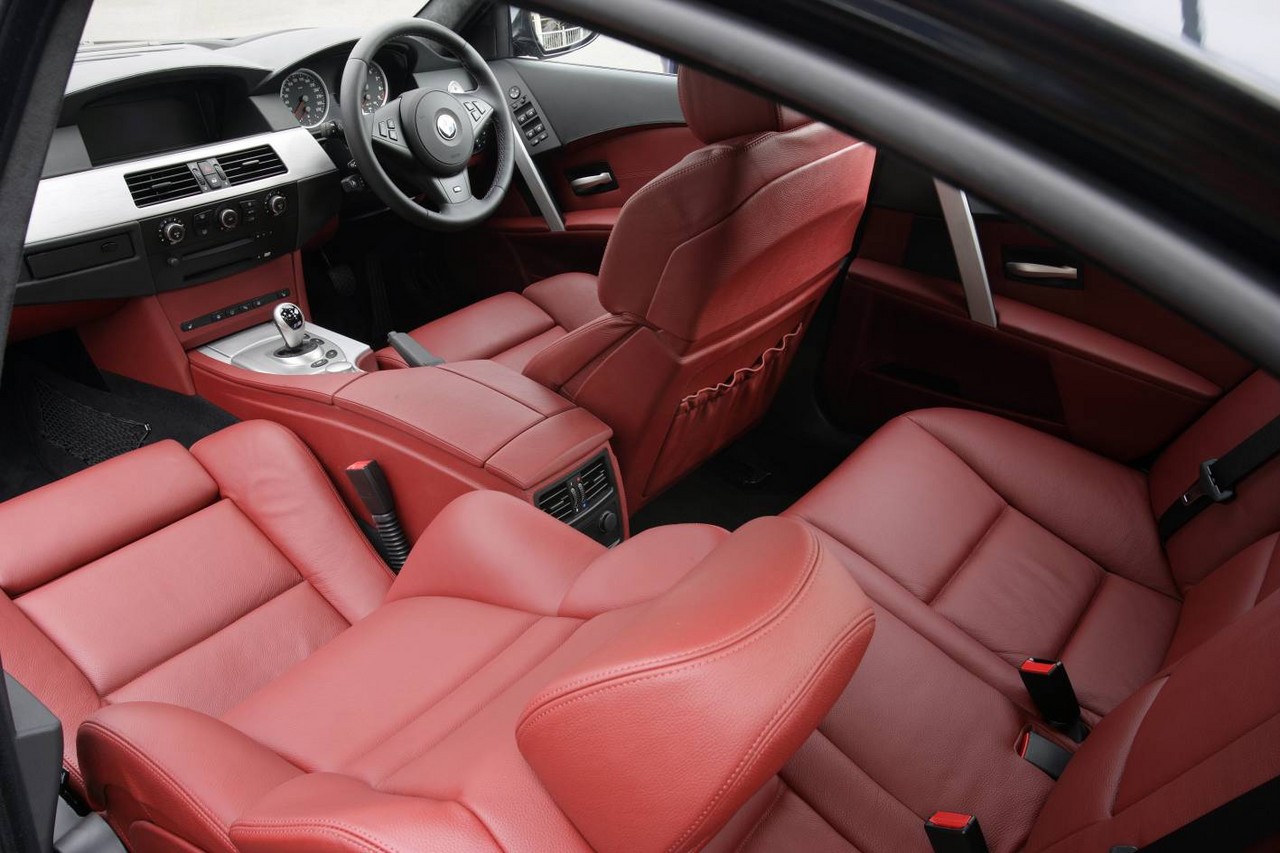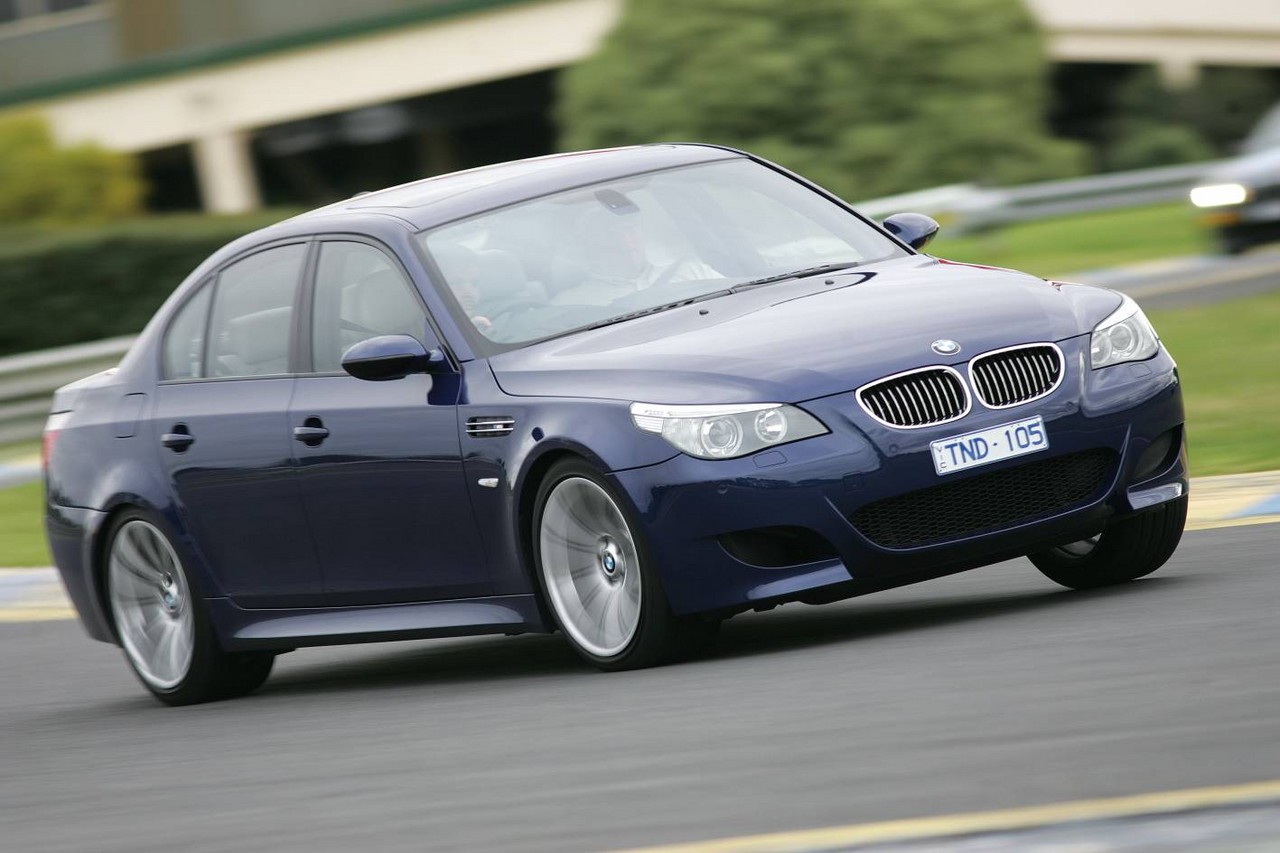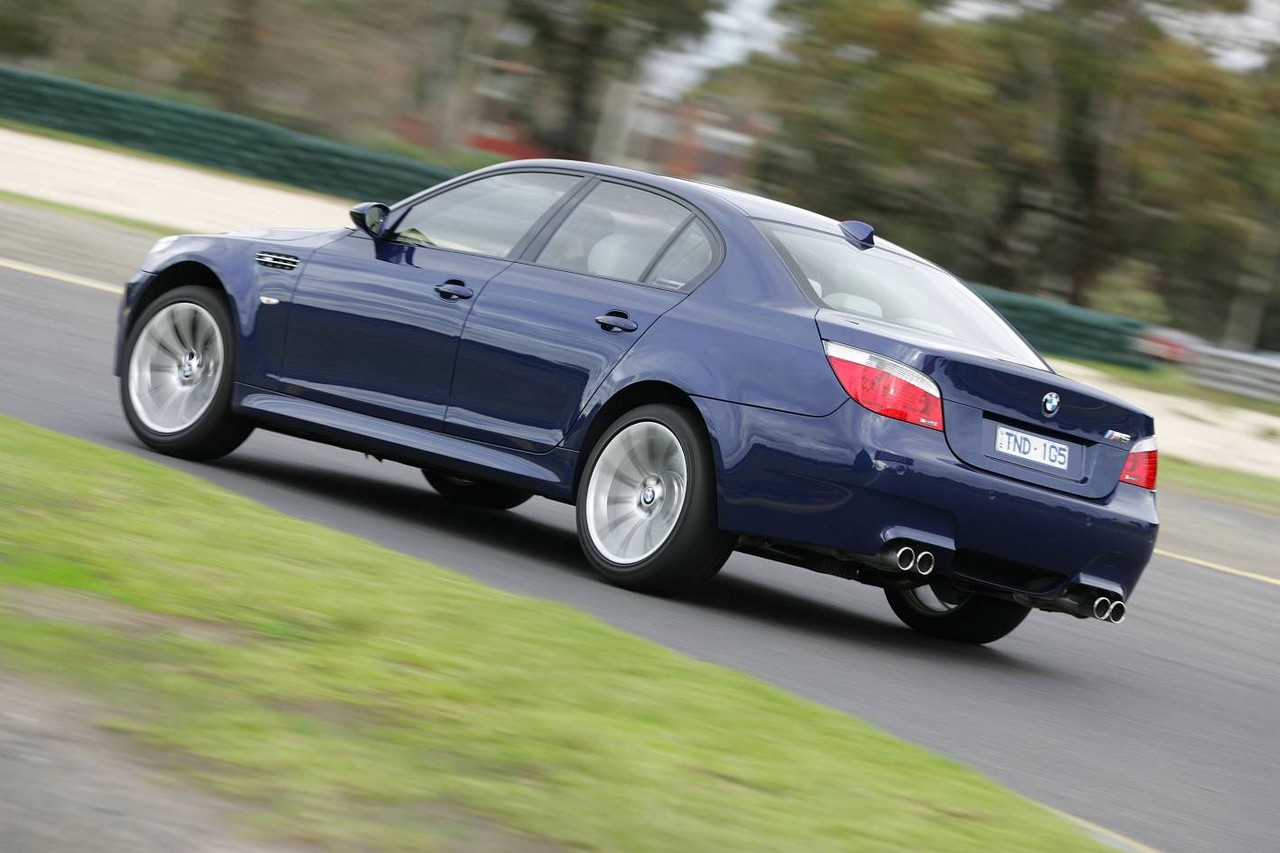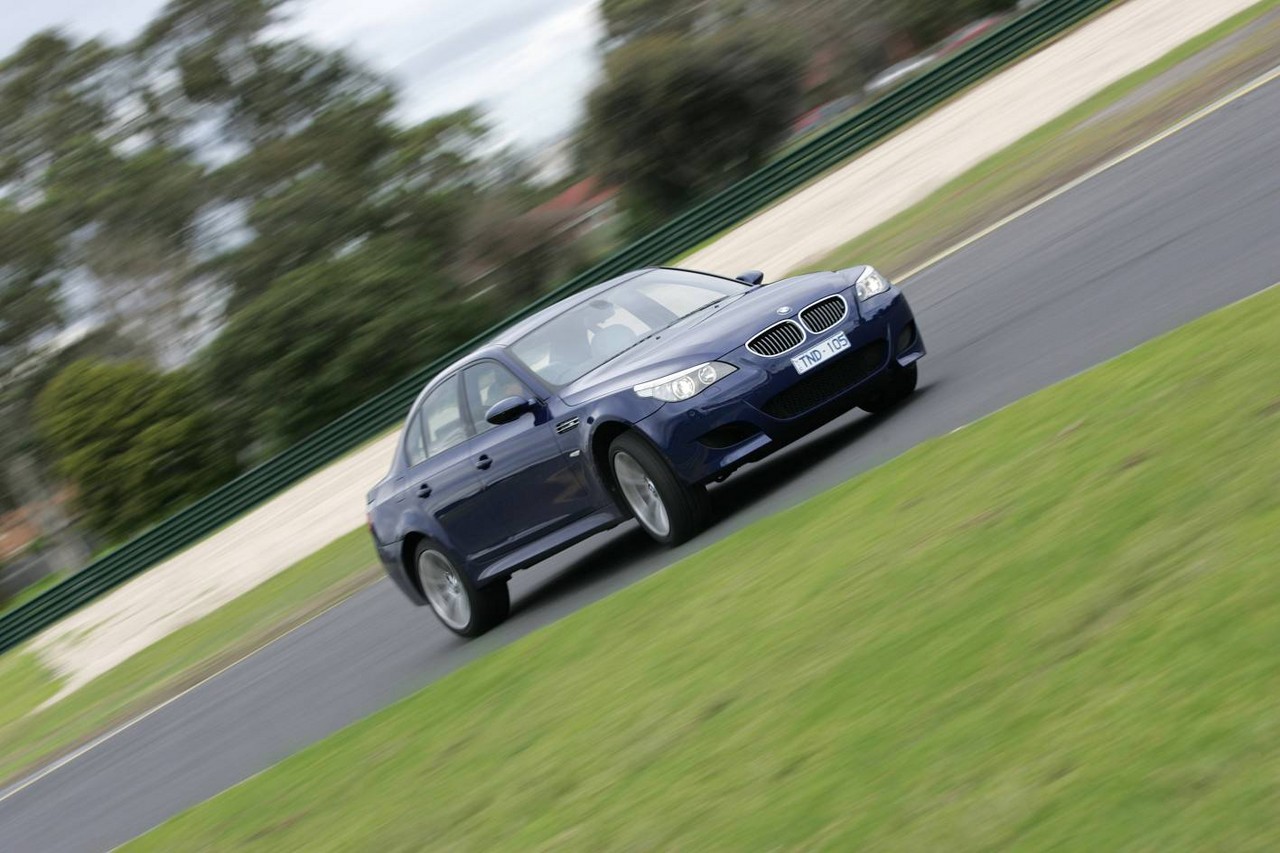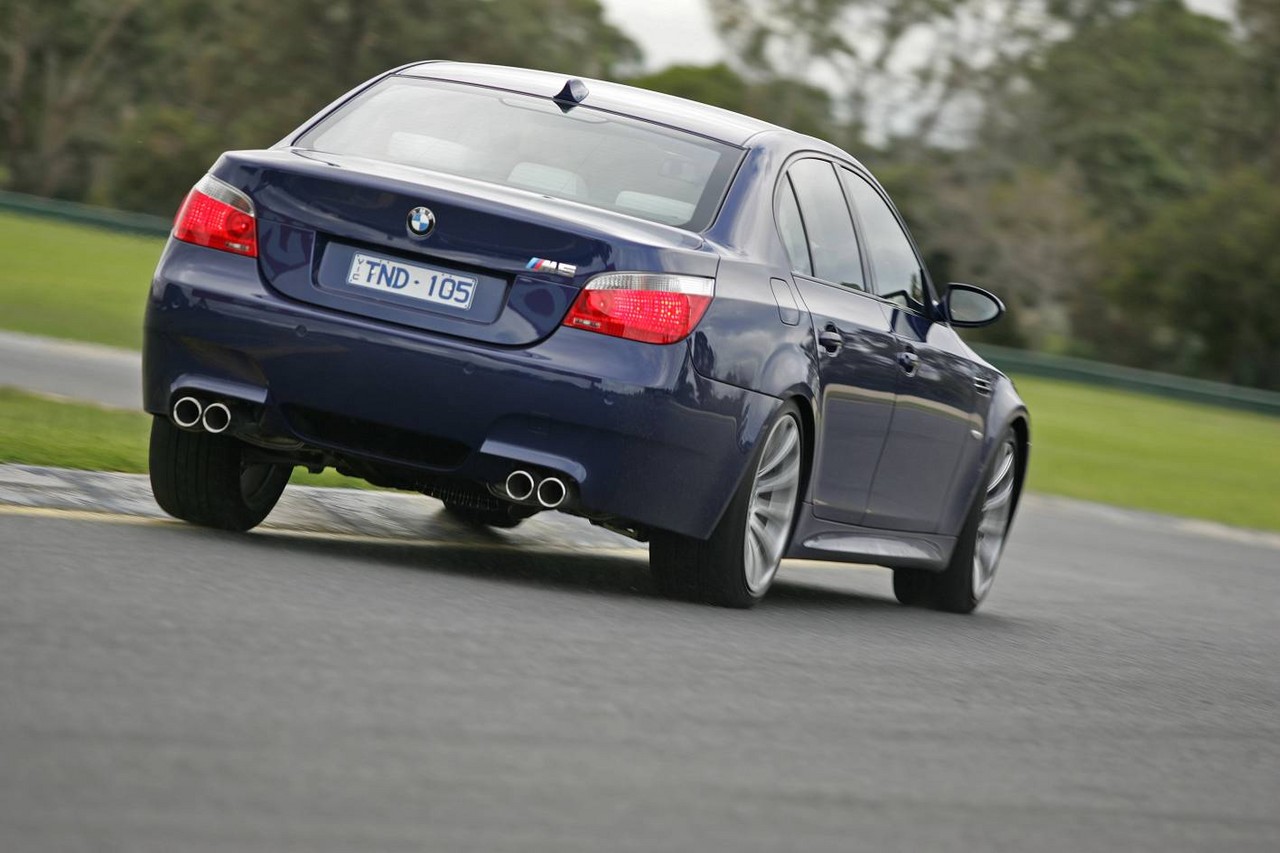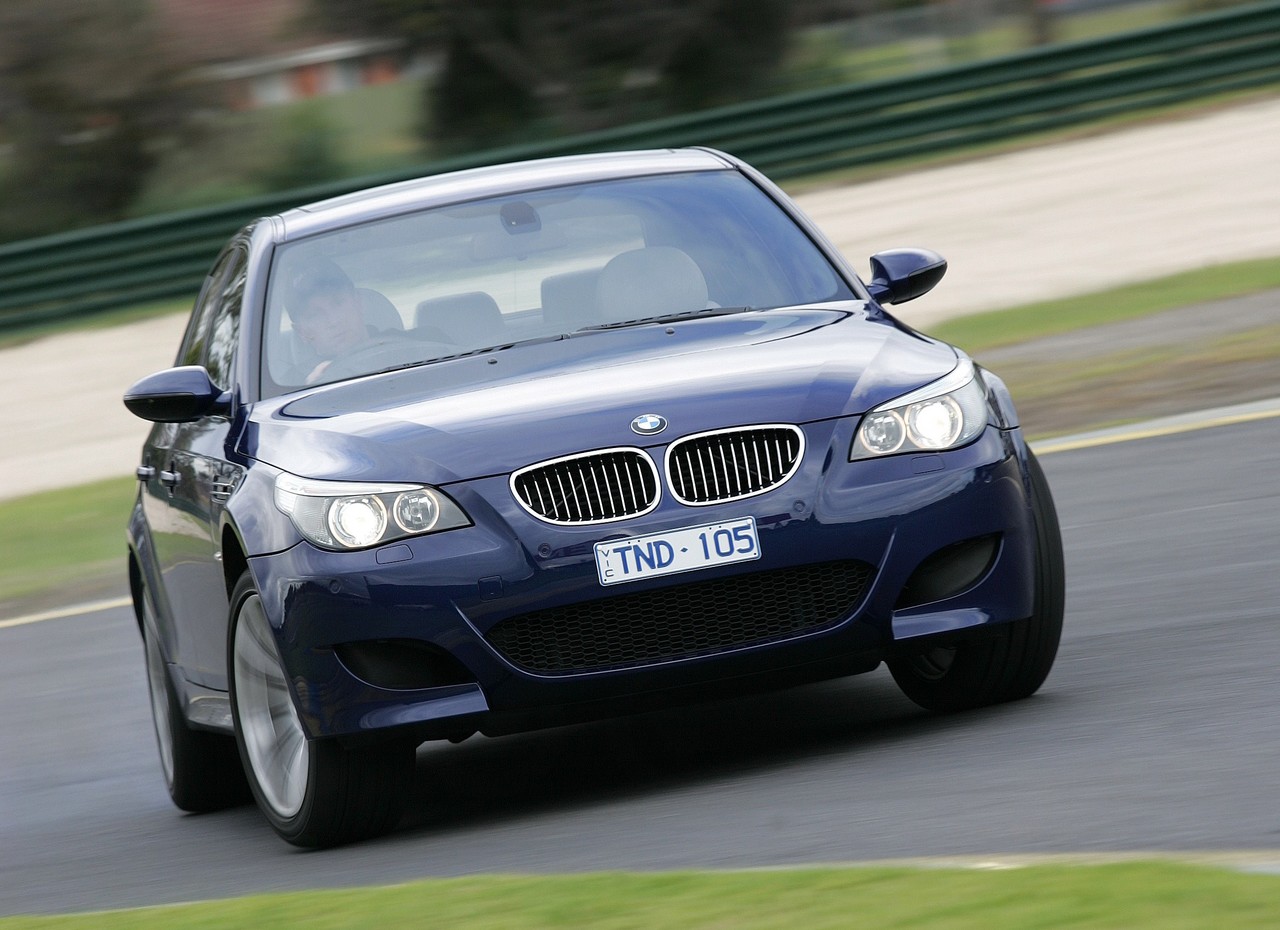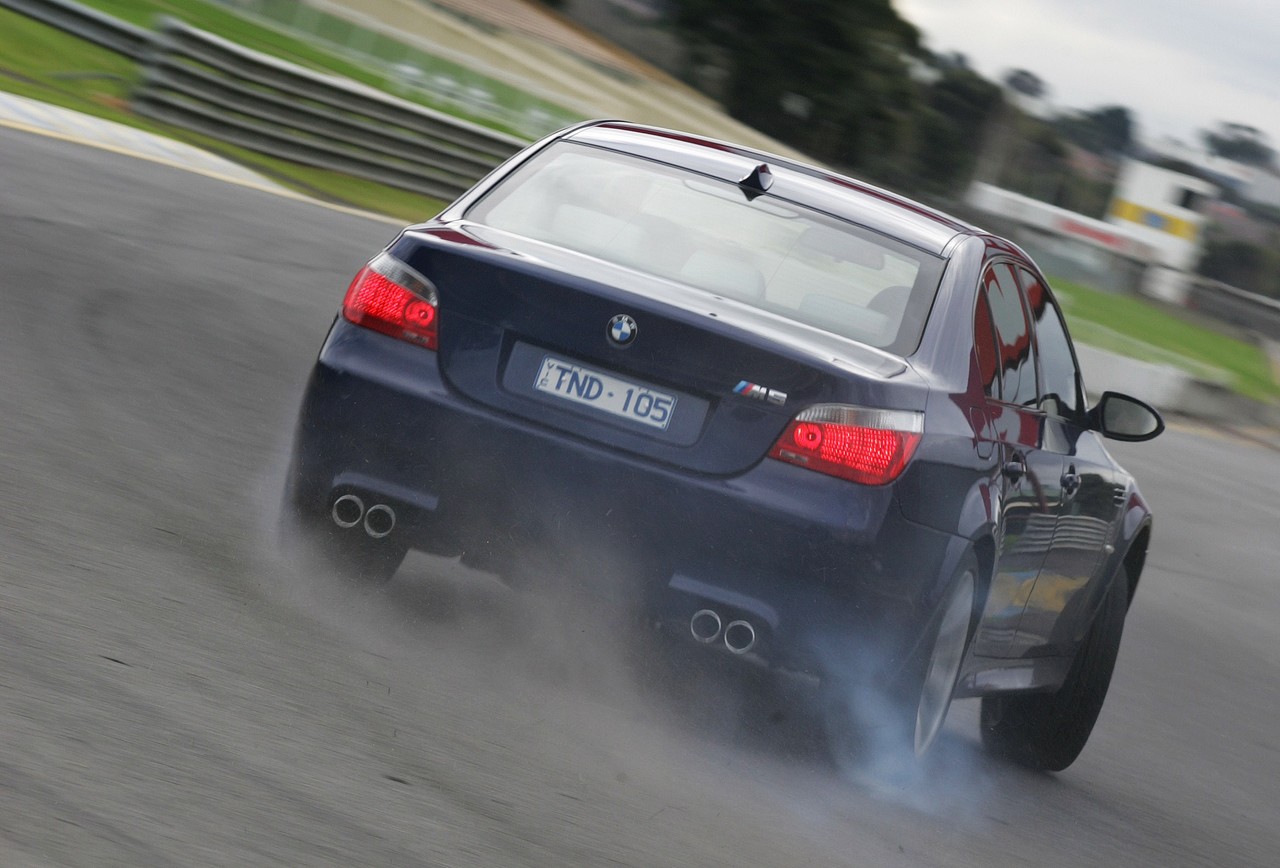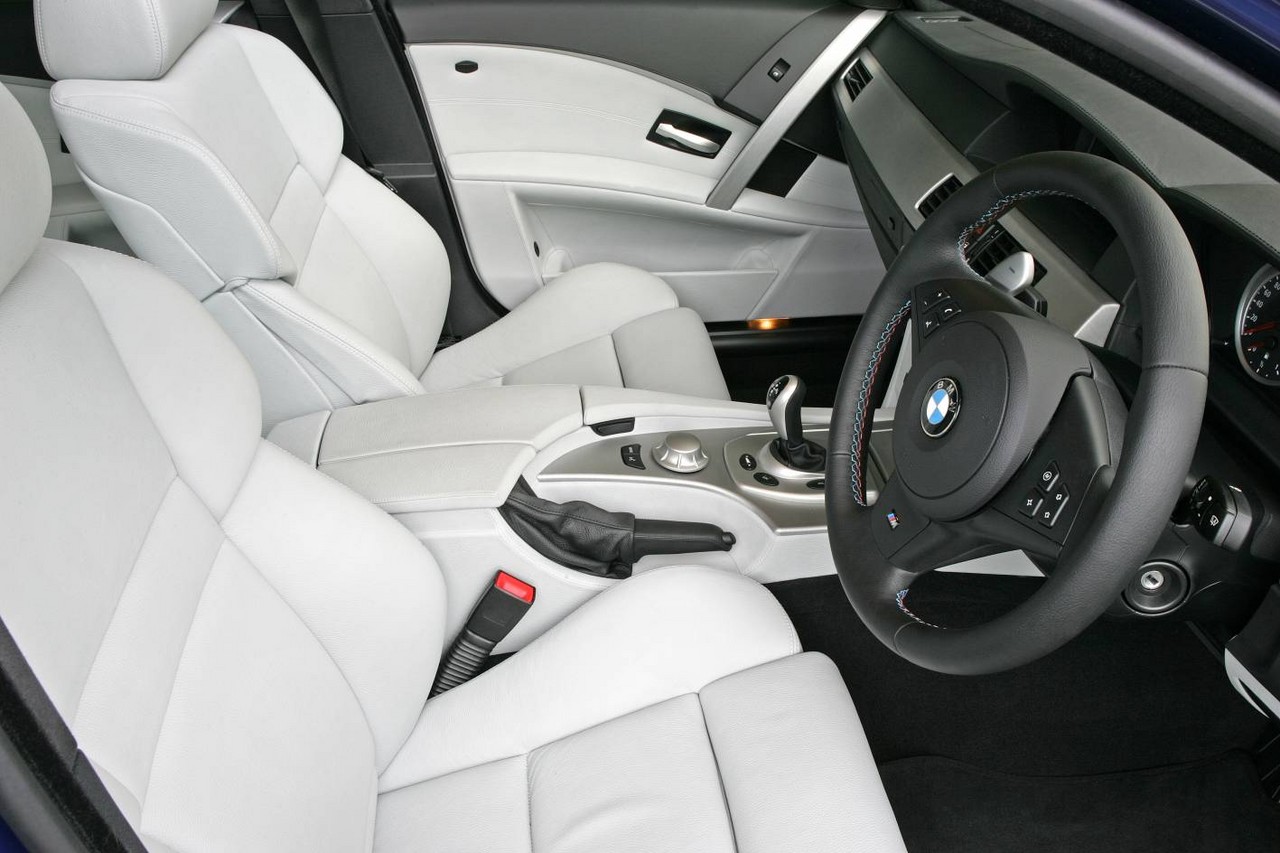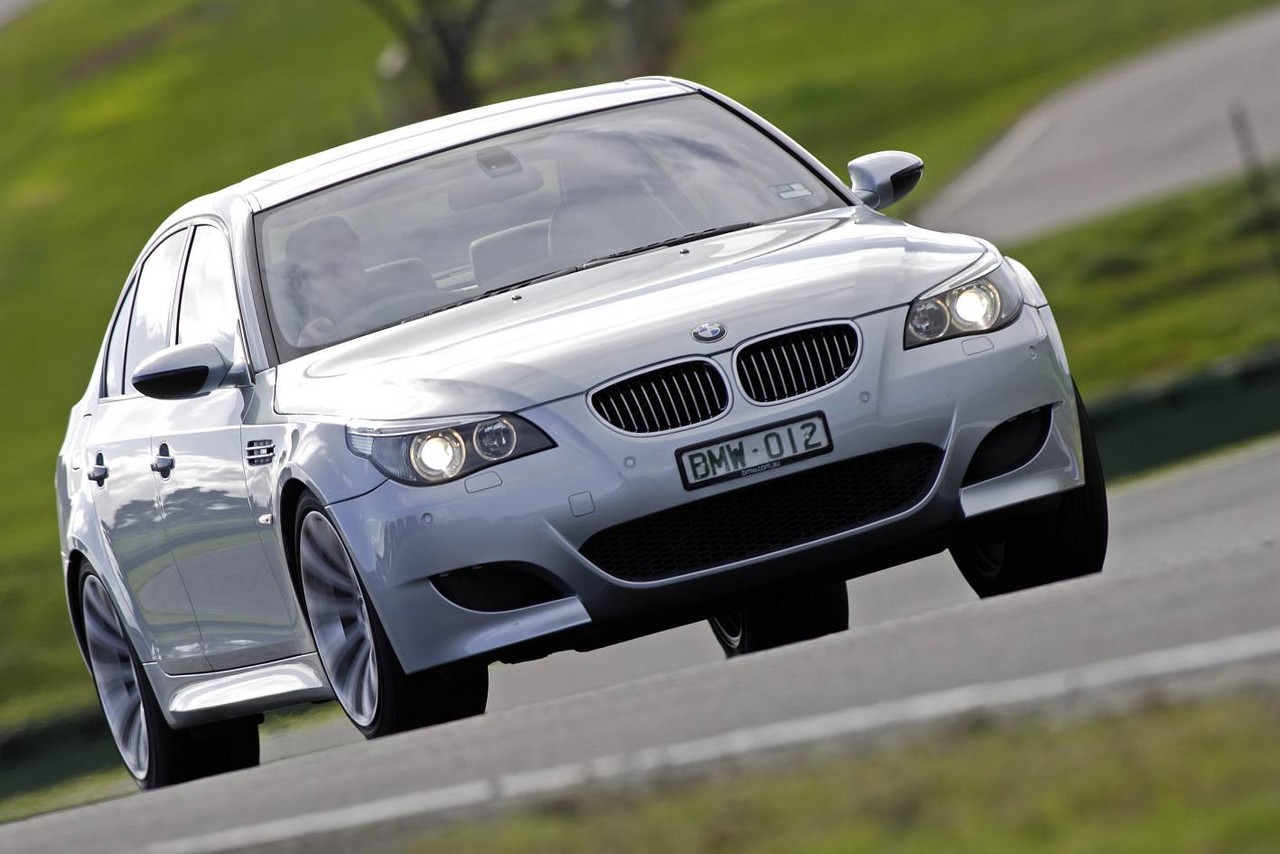
- Powerful, free-revving V10 engine
- Excellent dynamics
- Direct, accurate steering
- Supportive front seats
- V10 engine has peaky power delivery
- Semi-automatic transmission delivers disruptive gearshifts
- Weight dulls agility
- Insufficient connecting rod bearing clearance to journal ratio for S85 engine thought to cause premature wear of the rod bearings
Review: BMW E60.I M5 Sedan (2005-07)
Overview
Released in Australia in June 2005, the BMW E60 M5 was a performance, executive sedan. Manufactured in Dingolfing, Germany, the rear-wheel drive E60 M5 was powered by a 5.0-litre V10 petrol engine that was mated to a seven-speed semi-automatic transmission (BMW’s ‘Sequential Manual Gearbox’ or SMG).
S85B50 V8 engine
The E60 M5 was powered by BMW’s S85B50 V10 petrol engine which had a two-piece Alusil crankcase with reinforcing bedplate, a one-piece aluminium cylinder head, a forged steel crankshaft which operated on six bearings, cracked forged steel connecting rods, double overhead camshafts, four valves per cylinder, spherical valve tappets, BMW’s double VANOS variable intake and exhaust camshaft phasing, throttle assemblies for each cylinder, semi-dry sump lubrication and a compression ratio of 12.0:1. The S85B50 engine weighed 240 kg.
The S85B50 engine’s MS S65 engine management system used ionic current technology to detect engine knock, misfiring and combustion misses. The ionic current satellite received signals from the five spark plugs of each cylinder bank. Depending on engine load, the satellite amplified these signals and transmitted them to the engine management system for analysis.
The S85B50 engine had an 8250 rpm redline and enabled the E60 M5 to accelerate from rest to 100 km/h in 4.7 seconds and to 200 km/h in 14.4 seconds. While the M5’s top speed was electronically limited to 250 km/h, its theoretical top speed was in excess of 300 km/h.
Power modes
The E60 M5 had a ‘Power’ button on its centre console which could be used to activate the following modes:
- P400: power was limited to 400 horsepower (298 kW) and standard throttle response was provided; and,
- P500: provided maximum power (500 horsepower or 373 kW) and provided faster throttle response.
Beyond this, however, the ‘M Drive’ button on the steering wheel enabled the driver to select the ‘P500 Sport’ mode which provided maximum power and even greater throttle response.
Sequential Manual Gearbox (‘SMG III’)
The E60 M5 had BMW’s third-generation seven-speed Sequential Manual Gearbox (BMW’s ‘SMG III’) which had a single automated clutch. The driver could select from eleven ‘Drivelogic’ shift programs, five for automatic gear shifting and six for manual gear shifting which was controlled via the steering wheel gearshift paddles. Gear ratios for the SMG III were as follows: 3.985 (1st), 2.652 (2nd), 1.806 (3rd), 1.392 (4th), 1.159 (5th), 1.000 (6th) and 0.833 (7th); the final drive ratio was 3.620:1.
Furthermore, the SMG had the following functions:
- Wheelslip detection: sought to prevent wheelspin in the event of high drag torque on the rear axle, such as during downshifts on slippery surfaces, via ‘intelligently controlled clutch operation’;
- Launch Control: sought to improve traction and performed gearshifts just before maximum engine speed was reached for maximum acceleration; and,
- Hill recognition: provided faster gearshifts and specific shift maps in Drive mode when going uphill or downhill to avoid gear ‘hunting’.
Dimensions and body
Compared to its E39 M5 predecessor, the E60 M5 was 71 mm longer (at 4855 mm), 46 mm wider (1846 mm), 37 mm taller (1469 mm) and had a 59 mm longer wheelbase (2889 mm); boot capacity was 500 litres. Furthermore, kerb weight was reduced by 40 kg to 1755 kg, while the E60 M5 had a 50:50 front:rear weight distribution.
Next to the E60 5-Series sedan , the E60 M5 could be identified by its mesh grille, unique front fascia with large air intakes rather than fog lights, wider front guards with gills, unique rocker panels, M-designed door mirrors (claimed to reduce front axle lift at high speeds), more aggressive rear bumper with a central diffuser and lip spoiler.
Suspension
The E60 M5 had all-aluminium MacPherson strut front suspension and multi-link rear suspension. The suspension also included BMW’s ‘Electronic Damper Control’ (EDC) which consisted of electronically-controlled dampers that continually adjusted according to road conditions. The driver could also select from ‘Comfort’, ‘Normal’ or ‘Sport’ drive modes.
Compared to the standard BMW E60 5-Series , changes for the E60 M5’s suspension included:
- Modified front and rear subframes;
- Revised suspension geometry;
- Stiffer bushings;
- Hollow half-shafts;
- Unique rear suspension links;
- Different spring rates; and,
- 26.5 mm front and 18 mm rear anti-roll bars.
Steering
The E60 M5 had variable ratio, rack-and-pinion steering whereby the steering ratio varied according to the degree of lock applied; the mean ratio was 12.4:1. Power assistance (BMW’s ‘Servotronic’) was also varied according to vehicle speed and the EDC setting.
| Engine | Trans. | Peak power | Peak torque | |
|---|---|---|---|---|
| M5 | 5.0-litre petrol V10 (S85 B50) | 7sp SMG | 373 kW at 7750 rpm | 520 Nm at 6100 rpm |
Safety equipment
Standard safety equipment for the E60 M5 included dual front airbags, front and rear side airbags, full-length curtain airbags (i.e. for front and rear occupants), ABS, electronic brake force distribution, brake assist, electronic stability control (BMW’s ‘Dynamic Stability Control’, or DSC), cornering brake control, traction control, active front seat head restraints and front and outer rear seatbelts with pretensioners and load limiters.
Jointly developed by Teves and BMW, the Dynamic Stability Control system had an ‘M Dynamic Mode’ (MDM) setting which raised the yaw and wheelspin thresholds for intervention. The driver could also disable DSC.
Brakes
The E60 M5 had four-wheel vented and cross-drilled brake discs (374 mm by 36 mm front discs and 370 mm by 24 mm rear discs) with two-piece rotors; the front calipers had a dual-piston design.
Furthermore, the braking system had the following functions:
- Brake Standby: prepared for hard braking by pressuring the pad against the rotor when the driver abruptly reduced throttle input;
- Brake Drying: to keep the brake pads dry, the brake pad was pressed against the rotor when the rain sensor detected moisture; and,
- Start-Off Assistant: applied the brakes for one second after the driver’s foot was removed from the brake pedal for uphill acceleration from rest.
Features: E60 M5
Standard features for the BMW E60 M5 included 18-inch alloy wheels with 19-inch cast M Radial Spoke alloy wheels (‘Style 166M’), 19 x 8.5J front wheels with 255/40 ZR19 tyres and 19 x 9.5J rear wheels with 285/35 ZR19 tyres, a thirteen speaker Logic7 sound system with six-stack CD player, BMW’s ‘Professional’ satellite navigation system with a 6.5-inch monitor, TV tuner, Bluetooth connectivity and voice recognition, dual-zone climate control air conditioning, Merino leather upholstery, ‘M’ front sports seats with adaptive bolsters, power adjustable and heated front seats with memory settings, cruise control, directional bi-xenon headlights with high beam assist and washers, front and rear parking sensors, automatic headlights, rain-sensing wipers, a leather-wrapped steering wheel and gearshift, remote central locking, power mirrors and windows, automatically dipping door mirrors when reversing, a power adjustable steering column, head-up display (HUD), Alcantara headlining, front seat memory settings, electrochromatic rear-view and door mirrors, powered sunroof, glazed windows, rear and side blinds, tyre pressure monitoring, a trip computer, an alarm and immobiliser.
Unlike the E60 5-Series, the E60 M5 was not fitted with runflat tyres.
Variable M Differential Lock
The Variable M Differential Lock consisted of a shear pump and multi-disc clutch. Any difference in the rotational speed of the rear wheels would drive a shear pump which, in turn, increased pressure in the viscous silicon fluid that would cause the multi-disc clutch to engage and transfer torque to the rear wheel with greater traction. The greater the speed difference between the two wheels, the faster the clutch would engage.
MDrive
The BMW E60 M5’s ‘MDrive’ system enabled the driver to customise their preferences with respect to the SMG transmission, maximum engine power, throttle response, EDC damping, Servotronic steering assistance and DSC activation. These preferences could then be programmed (via iDrive) to activate to be engaged when the ‘M’ steering wheel button was pressed.
Production changes
During its production, the E60.I M5 underwent the following changes:
- September 2005: the ignition key replaced by start/stop button;
- March 2006: auxiliary audio input introduced; and,
- September 2006: navigation system enhanced.
Related links
Review: BMW E60.II M5 Sedan (2007-10)
Overview
Released in March 2007, the E60 Mk.II (E60.II) M5 could be identified by its updated head- and tail-lights, revised front airdam and front wheel lips. Inside, there was upgraded interior trim, a revised centre console and ‘favourite’ buttons were added to iDrive system to make it easier to use.
| Engine | Trans. | Peak power | Peak torque | |
|---|---|---|---|---|
| M5 | 5.0-litre petrol V10 (S85 B50) | 7sp SMG | 373 kW at 7750 rpm | 520 Nm at 6100 rpm |
Features
Standard features for the E60.II M5 were largely unchanged, though extra-cost options were extended to include:
- Comfort front seats (with active upper bolsters);
- ‘BMW Individual’ sound system with sixteen speakers;
- Soft-close doors;
- iPod/USB adaptor; and,
- A heated steering wheel.
Production changes
In September 2008, the iDrive controller was updated with fixed buttons; a Carbon Black metallic paint finish was also introduced.
September 2009 changes
In September 2009, a new iDrive system was introduced with hard drive-based navigation (80GB) system, larger screen and enhanced 3D graphics.
Related links
